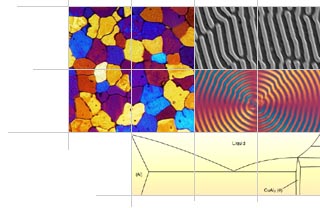Micrograph Library
Browse the libraryAdvanced searchSystemsCompositionsTechniquesKeywordsPhase diagramsHelpPreferencesAbout the micrograph libraryTerms of useContribute micrographs!FeedbackLinksCredits Print this page

Full Record for Micrograph 197

[358 KB]
View micrograph
.. in new window
View micrograph and record
.. in new window
You can also view and download the micrographs on Flickr
- Micrograph no
- 197
- Brief description
- Partially Stabilised Zirconia (PSZ)
- Keywords
- ceramic
 , engineering ceramic, tough ceramic, toughness
, engineering ceramic, tough ceramic, toughness  , zirconia
, zirconia - Categories
- Ceramic
- System
- ZrO2-MgO
- Composition
- MgO 2.5-3.6, ZrO2 97.5-96.4 (wt%)
- Standard codes
- Reaction
- Processing
- All commercial PSZ’s require a solution heat treatment at above about 1750ºC to develop a supersaturated solid solution prior to an ageing cycle which ideally forms tetragonal ZrO2 precipitates in a cubic matrix. Typical ageing temperatures are 1400-1500ºC.
- Applications
- Hip prostheses, thermal barrier coatings on turbine blades, feeler gauges, drawing dies.
- Sample preparation
- Grind, polish, ion thin and carbon coat.
- Technique
- Bright-field TEM
- Length bar
- 300 nm
- Further information
- The image shows cross sections through the oblate spheroid (like Smarties or M and M’s) tetragonal precipitates in the cubic matrix. On interaction with a propagating crack these transform to monoclinic symmetry expanding to close the crack so increasing toughness, so-called transformation toughening.
- Contributor
- Prof W E Lee
- Organisation
- Department of Engineering Materials, University of Sheffield
- Date
- 02/09/02
- Licence for re-use
 Attribution-NonCommercial-ShareAlike 4.0 International
Attribution-NonCommercial-ShareAlike 4.0 International

